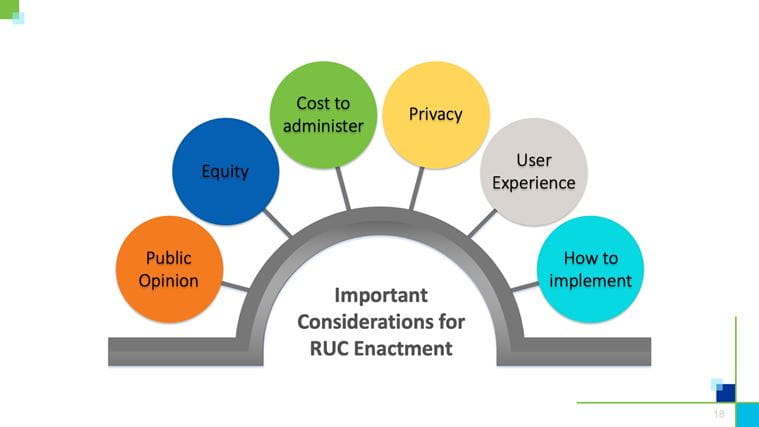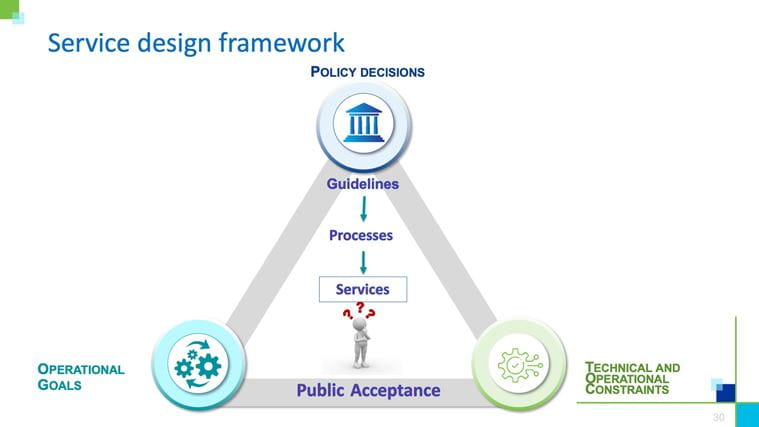Understanding Road Usage Charging: Basics and Benefits
Interested in a deeper dive of road usage charging? Check out our recent webinar with Roshini Durand, Andrew McLean, MPP, JD, Jennifer Roberts, PE, and Ging Ging Fernandez, PMP. Here is an overview of what they covered:
Situation Overview
Transportation infrastructure is funded by motor vehicles, license fees, and other taxes, fees, and tolls. Today’s revenue for transportation infrastructure is highly dependent on changes in vehicle fuel economy, sales in electric vehicles and related policies, and vehicle miles traveled. Corporate Average Fuel Economy (CAFE) standards are improving conventional vehicle fuel efficiency, and transportation electrification continues to gain traction as well. California just recently banned the sale of gas-powered vehicles, and states achieving their ZEV and efficiency goals will lead to declining fuel consumption. Growing amounts of revenue will be lost to fuel efficiency under the fuel tax. As a solution, states are seeking a new funding mechanism to replace the fuel tax, and are currently at various stages of maturity in developing RUC programs and pilots:

RUC Fundamentals
What is Road Usage Charge (RUC)?
- A roadway consumption tax with miles as the measure of consumption
- A “pay for what you use” approach to funding transportation
- A replacement of the fuel tax
Under a RUC system, also known as mileage-based user fee (MBUF) and vehicle miles traveled tax (VMT), vehicles are charged by miles driven versus fuel used. It is a replacement of the fuel tax, which has become more inequitable over the years as disparity in what users pay for transportation grows. Under RUC, all vehicles pay an equal amount for the same mileage. The RUC model adopts a “pay for what you use” approach, making it a more equitable payment for public roadways, and in this way has long-term funding sustainability.
Misconceptions: what RUC is not
- Congestion charging – it does not vary by time or location.
- Tolling – RUC charges for miles driven on all roads and funding applied to all roads.
Key players that constitute a complete and functional RUC system:
- Vehicle owner: generates distance traveled data for subject vehicle and submits payment.
- Account manager: collects payments and issues receipt. An account manager could be a third party of a state agency.
- State: remits net revenues to the appropriate fund and enforces data reporting and payment.
Federal Grant Programs for RUC:
- Fixing America's Surface Transportation (FAST) Act - Surface Transportation System Funding Alternative Grant Program (2016-2021)
- $95M over 5 years granted to states for demonstrating user-based alternative revenue mechanisms
- 50 percent match (can include toll credits & in-kind services)
- Application eligibility: State DOTs
- Bipartisan Infrastructure Law - Strategic Innovation for Revenue Collection Grant Program (2022 – 2026)
- Continues funding for RUC pilot programs: $75M over 5 years
- Match is 20 percent for new applicants; 30 percent for previous applicants
- Expanded application eligibility, including state DOTs, local governments, and MPOs
- Notice of Funding Opportunity expected September 2022
- $50M granted over 5 years for National RUC Pilot
The Role of Policy and Communications
No One Size Fits All Method in RUC Policy:
States can pursue paths to RUC implementation based on what works best for them. Different states can have different paths and still be successful with RUC enactment. Here are a few examples of successful RUC enactments:
Key Elements to Developing a Successful RUC Project
RUC development should be shaped by local policy objectives. Stakeholder engagement must be invested in to increase public understanding, and states must identify the right technology approach. Momentum can be built by expanding state networks. There are several key aspects to consider for RUC enactment:

Public opinion: People must be educated and communicated to about RUC.
Equity: Some believe that RUC could negatively impact rural areas, low-income households, or that certain cars would be penalized more. These concerns must be addressed.
Cost to Administer: Fuel tax is efficient, so implementing a RUC program also must be cost-efficient.
Privacy: Address how long data can be used for and limit access to data.
User Experience: Research is conducted in pilot programs to assess and optimize UX.
Important Policy Considerations for RUC Implementation
How to begin the program. Will it be mandatory for certain vehicles? Voluntary for certain vehicles? Or a hybrid between the two in which it is mandatory for some and voluntary for others?
How to collect payment. Will payments be collected annually? Periodically?
How to report mileage? There are many different available mileage reporting methods, including annual vehicle inspections, odometer reading (manual, photo), plug-in-device or third-party interfaces, and in-vehicle telematics.
How to ensure privacy. Possible options include enacting enhanced privacy protections, requiring manual reporting of miles where the government collects no personal data, or involving third-party account managers.
Setting the per-mile rate. Fee is per-mile based on what the average driver pays in gas tax and, at least initially, capping the rate for all vehicles.
Reducing overhead costs. A matter of balancing the transition away from the fuel tax while ensuring RUC is fair and equitable.
Policy is pointless unless there is public acceptance, and therefore communication is key. The public must understand the policy problem and be certain of why there is a need for a funding mechanism like RUC.
Key stakeholder engagement from policymakers and industry stakeholders is critical. The bottom line is that policy doesn’t work in a vacuum. It must be accompanied by comprehensive public engagement.
Service Design

For a state to implement RUC, the state must adopt a service design mindset, in which the user is involved throughout the solution design process.
What Can You Do?
There are many options for investigating RUC's potential:
- Join or become more active in a RUC research coalition
- Apply for federal grant funding
- Initiate a study or pilot in your state or region
- Enact a voluntary RUC program in your state
- Enact a limited RUC program in your state
- Begin transition planning









